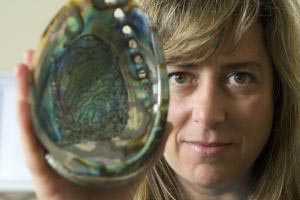Despite its common use in jewellery and for decoration, mother-of-pearl, or nacre, could be more suited to engineering applications. This natural material found lining the shells of sea creatures, such as oysters and abalones, is 3000 times less susceptible to fractures than the mineral, aragonite, from which it is made. Amazingly, driving a heavy lorry over an abalone shell will crack the shell itself but not the nacre lining.
Now, physicist Pupa Gilbert of the University of Wisconsin-Madison, and her colleagues there and at the Institute for the Physics of Complex Matter in Switzerland and the UW-Madison Synchrotron Radiation Center have taken the first steps to understanding how nacre forms and the secret of its great strength.

Gilbert holding an abalone shell (Photo: Jeff Miller)
Like bone and teeth, nacre is a biomineral composite made of 5 percent organic matter embedded in a calcium carbonate matrix. This small fraction of organic compounds provides the scaffolding on which the mineral matrix self-assembles from calcium carbonate dissolved in seawater. It is key to the very different mechanical properties of the mineral alone and its biomineral counterpart.
Gilbert and graduate student Rebecca Metzler used synchrotron radiation to shed light on the self-assembly process underlying abalone nacre formation. They examined a cross-section of abalone shell and found that it is not as uniform as earlier studies suggested. The polarized synchrotron light reveals that the layers of organic mortar separating individual inorganic crystalline bricks contains distinct clumps of bricks, each an irregular column of crystals with identical composition but a crystal orientation differing from their neighbouring columns.
The researchers suggest that nacre’s mosaic architecture endows it with its much greater strength than the uniform purely inorganic crystal. It is intuitive that a poly-crystal is mechanically stronger than a single crystal, so perhaps that is an advantage for the animal, Gilbert says.
The next step was to model how such a non-uniform structure could form. UW-Madison theoretical physicist Susan Coppersmith and her colleagues developed a computer model that suggests that the sea creature creates the organic mortar layers first, peppered with randomly distributed crystal seeding, or nucleation, sites. The mineral crystals start growing within the shell and extend horizontally until they touch another growing crystal and vertically until they hit the overlying mortar. If that crystal contacts another of the scattered crystal formation sites on the next tier up, it should trigger growth of a new crystal with the same crystal orientation, gradually building a rough column of irregular width.
The team hopes to refine this model with additional experimental work as well as to examine other biominerals, including human teeth and nacre from pearl oysters, mussels, and the nautilus. Ultimately, they want to be able to emulate nature to make novel engineering materials with similar properties. If you understand how it forms, you could think of reproducing it, producing a synthetic material that’s inspired by nature – a so-called ‘biomimetic’ material, Gilbert says.
Further reading
Phys Rev Lett., 2007, 98, 268102;
http://dx.doi.org/10.1103/PhysRevLett.98.268102
Pupa Gilbert Research Group homepage
http://home.physics.wisc.edu/gilbert/
Susan Coppersmith homepage
http://uw.physics.wisc.edu/~coppersmith/
Synchrotron Radiation Center
http://www.src.wisc.edu/